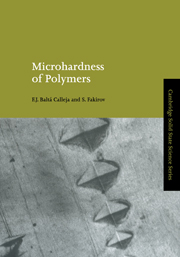Book contents
- Frontmatter
- Contents
- Preface
- Chapter 1 Introduction
- Chapter 2 Microhardness determination in polymeric materials
- Chapter 3 Microhardness of glassy polymers
- Chapter 4 Microhardness of crystalline polymers
- Chapter 5 Microhardness of polymer blends, copolymers and composites
- Chapter 6 Microhardness of polymers under strain
- Chapter 7 Application of microhardness techniques to the characterization of polymer materials
- Author Index
- Subject Index
Chapter 2 - Microhardness determination in polymeric materials
Published online by Cambridge University Press: 23 October 2009
- Frontmatter
- Contents
- Preface
- Chapter 1 Introduction
- Chapter 2 Microhardness determination in polymeric materials
- Chapter 3 Microhardness of glassy polymers
- Chapter 4 Microhardness of crystalline polymers
- Chapter 5 Microhardness of polymer blends, copolymers and composites
- Chapter 6 Microhardness of polymers under strain
- Chapter 7 Application of microhardness techniques to the characterization of polymer materials
- Author Index
- Subject Index
Summary
The microhardness of a polymeric material – resistance to local deformation – is a complex property related to mechanical properties such as modulus, strength, elasticity and plasticity. This relationship to mechanical properties is not usually straightforward, though there is a tendency for high modulus and strength values to correlate with higher degrees of microhardness within classes of materials. Microhardness has no simple, unambiguous definition; it can be measured and expressed only by carefully standardized tests (see Section 1.1).
Scratch tests have been used for microhardness measurements of polymeric materials (Bierbaum Scratch Hardness Test (ASTM D 1526)). These tests are related to cuts and scratches, and, to some extent, to the wear resistance of materials. Scratch tests are not always related to the resistance to local deformation and they are now being replaced by the preferred indentation test.
In the indentation test, a specified probe or indenter is pressed into the material under specified conditions, the depth of penetration being a measure of the microhardness according to the test method used. The duration of a microhardness measurement must be specified because polymeric materials differ in their susceptibility to plastic and viscoelastic deformation. An indenter will penetrate at a decreasing rate during application of the force, and also, the material will recover at a decreasing rate, reducing the depth of penetration, when the force is removed. Therefore, length of time that the force is applied must be specified. For most elastomers, the indentation will disappear when the force is removed.
- Type
- Chapter
- Information
- Microhardness of Polymers , pp. 11 - 45Publisher: Cambridge University PressPrint publication year: 2000
- 5
- Cited by

